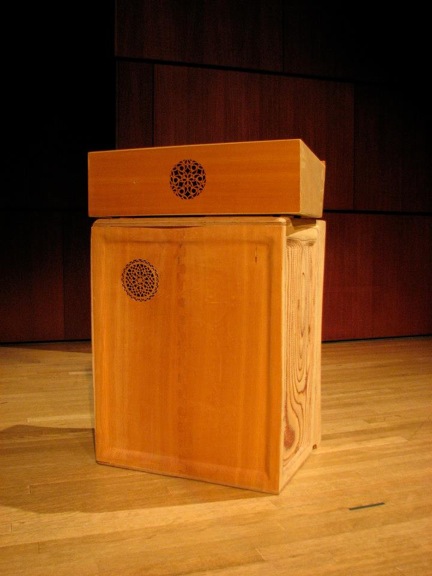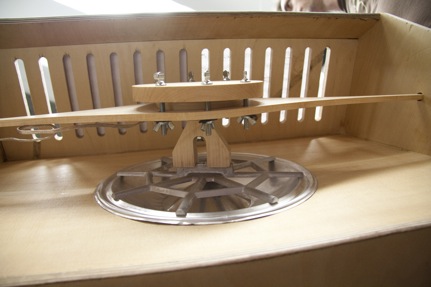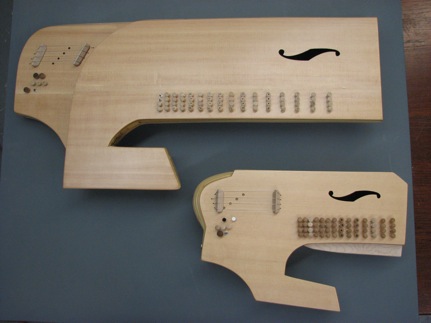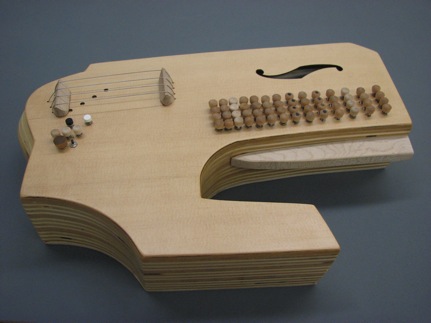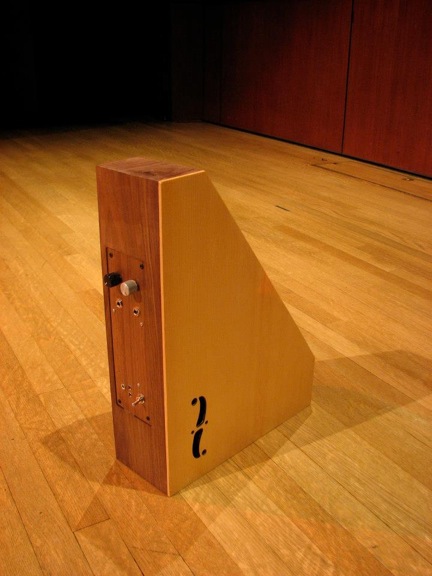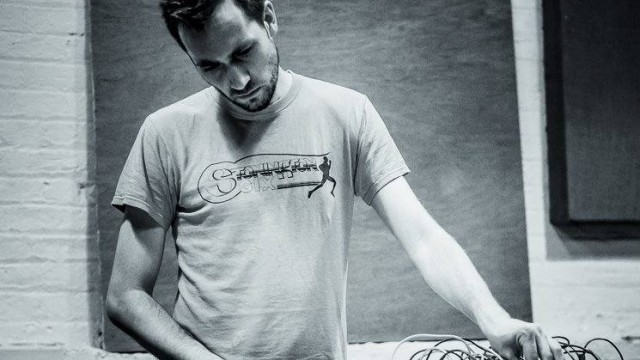
Jeff Snyder
Undeciphered Writing
About the piece:
“In roast you are a guest of the ducks – go dream!” – attempted translation of the Sitovo inscription, written in an unknown script.[1][2]
This piece is written for an ensemble of instruments designed and built by me, the composer. The music is inspired by examples of writing that have been discovered but never definitively translated, ranging from intentional codes to ancient scripts for which the spoken language is unknown or cannot be identified.
Here are some details about the construction of the piece, the theory behind it, and an explanation of the instruments involved.
The Instruments:
The ensemble is comprised of three main types of instruments—the Mantas, the Contravielles, and the Forceboxes. There are two Manta performers, two Contravielle performers, and six Forcebox performers. With a conductor, the piece requires a total of 11 players.
The Mantas:
The Manta is a touch-sensitive keyboard instrument that is designed to feed continuous information about the varying touch on the surface of the keys to an audio synthesis program.
The layout is a hexagonal grid, with each hexagon representing a pitch. In this piece, the pitch layout mimics that of a piano keyboard (you can see the pattern of the black and white keys in the image below).
The amplitude of each of these pitches in controlled by the surface area covered by the player’s finger. As the performer rolls their finger to cover more of the sensor, the volume of the note increases. This allows for expressive gestures not usually possible on a keyboard instrument.
Each of the Manta performers has two Manta keyboards, so that a wider range of pitches is available than would be possible with only one. The two Mantas for each performer are perched atop a resonator body, which also serves as a kind of podium for the Manta player. Instead of being sent to traditional speakers, or even the hemispherical speaker arrays that Sideband uses for most pieces, the sound the Mantas make is transmitted by the physical vibration of these resonator bodies. There are magnetic driver transducers inside them that drive the surfaces of the resonators with the electronic signal.
There are two different Manta resonators used in the piece. The Bass Manta is played by Anne Hege, and its construction is inspired by that of a double bass. It has a carved spruce front, a maple back, and a sound-post that connects the front to the back. Inside the resonator is a maple “bridge” that connects the driver transducer (the HAS-801) to the inside of the spruce front. The Helmholtz resonance of the box is tuned to be similar to that of a double bass. [3] On top of the main bass box, I place another resonator that I call the midrange pulpit, which helps to deliver a bit of midrange bite to the sound when necessary. I tend to use this instrument as the bass of the ensemble.
The Resophonic Manta is played by Konrad Kaczmarek. It uses a design borrowed from the resophonic guitar, invented by the Dopyera Brothers in the 1930s. A spun aluminum cone is placed in a hole on a spruce top plate, and the bridge connects to this aluminum cone. In place of the guitar strings usually employed in this system, I have connected a driver transducer to the bridge of the resophonic cone, so that I can drive it with electronic signal generated by the Manta controller. The sound of the Resophonic Manta has an unusual metallic growl, and some very strong resonances that give it a characteristic “wookie” roar when played at loud volumes.
The Contravielles:
The Contravielles are the string instruments of the ensemble. They are actually something of an abstraction of what a string instrument is: the left hand selects pitches on virtual “frets” and the right hand determines the amplitude of the notes on those virtual “strings”. The tuning of the “strings” can be programmed to be similar to a violin, viola, bass guitar, or any other configuration, so that the performer can easily find the notes. The idea of the buttons on the body of the instrument was inspired by a Swedish instrument called the nyckelharpa, a type of keyed fiddle, which has buttons to mechanically fret the strings like a hurdy-gurdy, creating a non-vibrato sound, but allows the player to directly bow the strings, which gives a more expressive character than the mechanized wheel of a hurdy-gurdy. The visual design was inspired by Singer sewing machines, and the desire to avoid an obviously guitar-like form.
 The Contravielle comes in two sizes, the Treble Contravielle played by Michael Early, and the Tenor Contravielle, played by Ariane Alexander. On these instruments, the body of the instrument itself is the resonator – there is a transducer screwed into a maple bridge on the inside of the spruce top so that the wooden body of the instrument transmits the electronic sound. Those f-holes aren’t just for show!
The Contravielle comes in two sizes, the Treble Contravielle played by Michael Early, and the Tenor Contravielle, played by Ariane Alexander. On these instruments, the body of the instrument itself is the resonator – there is a transducer screwed into a maple bridge on the inside of the spruce top so that the wooden body of the instrument transmits the electronic sound. Those f-holes aren’t just for show!
Electronically, both of the instruments are the same, and could produce any range of notes, but the larger body of the Tenor instrument gives it more acoustic power in the low register.
The Forcebox:
 Four of the Forceboxes form a kind of background chorus in this piece. These are the most utilitarian of the instruments, with less visual flair than the other instruments. They were based on the design of video game controllers, but with a couple additions that are useful in musical performance that video game controllers tend to omit. For instance, parameters that stay where you set them, i.e. knobs, are usually absent from game controllers. Also, I thought that continuous finger pressure would be a nice addition to the game controller idea. Therefore, the Forceboxes have two FSRs (force-sensing resistors) that sense continuous pressure values from the performers thumbs on the device, a row of three knobs, four momentary pushbuttons, four color-coded LED lights, and a three-axis accelerometer, which senses the position of the box in space. The right thumb FSR sensor is mapped to control the overall volume, and the left thumb sensor to control pitch bending. The yellow button switches from a pitched tone to filtered white noise, and the three knobs control parameters like which overtone above a given fundamental the box should play. The pitches that the Forceboxes can play are pre-programmed, and the performer steps through them in order using the buttons, with visual feedback from the LEDs to show which note will sound. The accelerometer controls filter cutoff.
Four of the Forceboxes form a kind of background chorus in this piece. These are the most utilitarian of the instruments, with less visual flair than the other instruments. They were based on the design of video game controllers, but with a couple additions that are useful in musical performance that video game controllers tend to omit. For instance, parameters that stay where you set them, i.e. knobs, are usually absent from game controllers. Also, I thought that continuous finger pressure would be a nice addition to the game controller idea. Therefore, the Forceboxes have two FSRs (force-sensing resistors) that sense continuous pressure values from the performers thumbs on the device, a row of three knobs, four momentary pushbuttons, four color-coded LED lights, and a three-axis accelerometer, which senses the position of the box in space. The right thumb FSR sensor is mapped to control the overall volume, and the left thumb sensor to control pitch bending. The yellow button switches from a pitched tone to filtered white noise, and the three knobs control parameters like which overtone above a given fundamental the box should play. The pitches that the Forceboxes can play are pre-programmed, and the performer steps through them in order using the buttons, with visual feedback from the LEDs to show which note will sound. The accelerometer controls filter cutoff.
The four primary Forcebox performers are producing sound through wooden resonators that I call the Triangle Resonators, co-designed with Jason Marshall. This is a portable wooden box that has a spruce top and walnut sides with a transducer affixed to the inside.
Two additional Forcebox players use a different sound generation patch, which generates an algorithmic sequencer pattern based on the controls. This is the messy, noisy, busy texture that is most prominent coming in around 8:40 in the piece. Unlike the primary four Forceboxes, these performers use large timpani drums as resonators, with the driver transducers simply resting on the heads of the drums. This gives the instrument a reverberant, midrange-peaky overdriven sound.
The Tuning System:
From a compositional standpoint, I am interested in intervals between pitches that are not represented in the usual 12-tone equal temperament (12-TET) familiar to musicians from the piano. This piece uses a just intonation system, which means that all of the frequencies of the notes are related to each other by whole-number ratios (such as 5/4 or 11/8). For more information about just intonation, check out Kyle Gann’s page, or this excellent book by David Doty. Just intonation creates the possibility for much stronger consonances and much juicier dissonances than are possible in 12-TET. However, one of the practical problems when working with just intonation is that if you limit yourself to, for instance, 12 pitches per octave, you are not able to modulate to a new pitch area, or things will be out of tune. One alternative is to create a pitch system with more notes per octave (Harry Partch’s famous system uses 43). However, having a large number of notes causes difficulty for the performers who have to navigate such a complex array of pitch possibilities. My system takes advantage of the fact that all the instruments are electronic, and allows the performer to dynamically select between different subsets of 12 pitches from a full gamut of 168 pitches per octave. The retuning is done electronically, but under the performer’s control (rather than automatically). This simplifies the notation, so that I can write in standard Western music notation with the usual notes and accidentals. My system only requires that the performers are instrumented with a few additional controls:
- Buttons which allow them to select from 3 different 12-note scale collections (Otonal, Utonal, and “Normal”)
- A “tune” button, which lets the user retune the chosen scale to one of 12 different fundamental “reference” pitches.
This way, the notation can simply mark an “O” when the performer needs to select the otonal scale, and mark “tune A” when the performer needs to push the button to retune the scale to an A fundamental, and then continue using traditional 12-note standard notation. More information about this tuning system can be found in my doctoral thesis: Exploration of an Adaptable Just Intonation System. If you want to analyze the score, this table gives the absolute pitches that result from the various retunings in the notation, and this page demonstrates some pitch analysis of the first page of the score using this table.
The Structure of the Piece:
Undeciphered Writing has an unusual form. The opening is murky and unclear, with ominous tones in the Bass Manta and dissonant pitch discrepancies until about the 5-minute mark. At that point, strange and fragmented psuedo-tonal melodies appear, but in relative isolation, separated by silence and negative space. This point of familiarity then dissipates into another section of occluded phrases without a clear grounding by the 7-minute mark. At 8:45, another moment of clarity occurs, with strong triadic chords in a repeated series, but this uncomfortably exposed chordal phrase is obscured by a crackly, messy texture that doesn’t seem to relate. After a single repeat, the chordal phrase sinks into oblivion, with a dark low gurgle punctuated by half-synchronized noise bursts.
My intention in this form was to give the listener something of the mystery and wonder of viewing one of these examples of undeciphered writing alluded to in the program note, some strange ancient text which must have meaning but for which the key has been lost. The unbalanced form, with the majority of the activity happening before the halfway point, to me suggests the incomplete fragments of stone tablets that have been broken off in unpredictable ways by the elements. The melodic fragments perhaps represent the “crib”, elements of the undeciphered text with some familiar structure that could suggest the meaning. In deciphering ancient texts, often a structural similarity to known languages provides the key to understanding the nature of the language. However, these melodic fragments seem incomplete, and the chords that follow are similarly unresolved and masked by decay. Ultimately, it is only a fleeting glimpse into a culture that will forever remain foreign to the listener.
Performers:
- Konrad Kaczmarek – Resophonic Manta
- Anne Hege – Bass Manta
- Michael Early – Treble Contravielle
- Ariane Alexander – Tenor Contravielle
- Lainie Fefferman, Dan Trueman, Daniel Iglesia, and Rebecca Fiebrink – Forcebox with Wooden Resonator
- Jeff Snyder and Cameron Britt – Forcebox with Timpani Resonator
- Jascha Narveson – Conductor
Score to be found here.
Contact me if you are interested in performing the piece. Depending on the logistics, I could come to your ensemble to bring the instruments and rehearse it with you, or you could rent the instruments. A less visually striking but sonically similar version of the piece is possible with the larger resonators eliminated for practical purposes, and the further simplified versions of the piece are possible with more conventional instrument solutions.
- [1] http://www.korenine.si/zborniki/zbornik06/serafimov_sitovo06.pdf
- [2] http://en.wikipedia.org/wiki/Sitovo_inscription
- [3] http://www.speech.kth.se/prod/publications/files/qpsr/1982/1982_23_4_149-174.pdf

